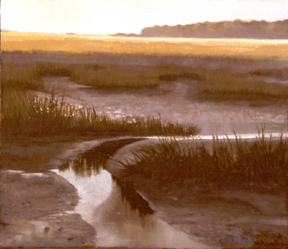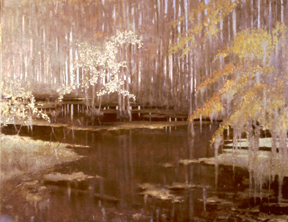

| For more information about this article or gallery, please call the gallery phone number listed in the last line of the article, "For more info..." |
May Issue 2004
Carolina Galleries in Charleston, SC, Offers Works by Craig Crawford
 Carolina
Galleries in Charleston, SC, is proud to present the first solo
exhibition, Atmosphere and Light, featuring works by Craig
Crawford opening May 21 and running through June 14, 2004. Crawford
will also be at Carolina Galleries on Sat., May 22 at 2pm to speak
about his work. Carolina Galleries has shown his work since 1995.
Carolina
Galleries in Charleston, SC, is proud to present the first solo
exhibition, Atmosphere and Light, featuring works by Craig
Crawford opening May 21 and running through June 14, 2004. Crawford
will also be at Carolina Galleries on Sat., May 22 at 2pm to speak
about his work. Carolina Galleries has shown his work since 1995.
Crawford was born on the coast of California
and moved to Aiken County, SC, at age 8. He now lives in Columbia,
SC. He trained as both a painter and conservator. Surrounded
by the watercolor portraits and architectural paintings by his
grandfather, it was natural for him to lean towards art. His grandfather
was both a painter and architect who studied at Beaux Arts and
National Academy in Rome. Crawford was in the first Governor School
for the Arts' class in South Carolina. He received a BFA from
University of South Carolina where he learned the glazing and
scumbling techniques that he still employs. He began painting
as a teenager with his early work being figurative. The artist
was very drawn to figurative sculpture (due to tactile aspect)
but moved to painting as he felt he could create more of an atmospheric
environment in painting. Crawford's interest was in the physical
elements of painting; how layers were put down, how artists deal
with edges, how an artist makes marks that looked arbitrary but
naturally occurring.
With his interest in materials and techniques Crawford decided
graduate school in conservation would be the way to gain information.
Instead, he received a five year apprenticeship with Charles
Olin who started the Smithsonian National Portrait Gallery conservation
lab. He worked for three additional years with Olin. Painting
while working as a conservator in Washington, he became aware
of 18th and 19th century American landscape paintings. Crawford
had access to the conservation documentation on those works, which
gave the detailed information on methods and materials.
Nature became the logical subject for Crawford since he began backpacking as a young child. He had painted the landscape of Aiken's sand hills and Hitchcock Woods and spent the summers on Kiawah Island, SC. In his early 20s, Crawford would ride his bike to then empty lots and paint on location. He later decided he could do more in the studio as painting en plein air felt rushed and in the studio there was more freedom to use glazes, rework, scrape down and repaint. He uses reference photos and memory for work, but he does still paint on location for studies.
 Crawford
finds plein air painting distracting because he cannot just experience
the location and time; he feels he must be productive. Dealing
with people, the changing light, insects and weather changes makes
it harder to let spontaneous things happen in the work because
of the focus on the already determined scene being painted. Events
such as ripples on the water or a bird landing can be captured
on film and played with in the studio but it is much more difficult
to be flexible en plein air. He feels he is looser in the studio
and tighter on location perhaps because he feels married to the
likeness when he is viewing it in person.
Crawford
finds plein air painting distracting because he cannot just experience
the location and time; he feels he must be productive. Dealing
with people, the changing light, insects and weather changes makes
it harder to let spontaneous things happen in the work because
of the focus on the already determined scene being painted. Events
such as ripples on the water or a bird landing can be captured
on film and played with in the studio but it is much more difficult
to be flexible en plein air. He feels he is looser in the studio
and tighter on location perhaps because he feels married to the
likeness when he is viewing it in person.
Crawford is acutely aware of using quality materials but does not allow the knowledge gathered through conservation work to get in the way of his painting. Excited about techniques, the artist experiences freedom to explore since his subject is already determined. Creating mood, atmosphere and light, the emotive characteristics of the artist are expressed in his paintings. He feels technique allows creation of the effects that express emotional quality. The artist is often criticized for making "dark paintings." In his words, "dark and moody is an expected, clichéd description of artists. Others believe that artists go through phases of emotion, moodiness." Crawford believes artists express it in painting. Non-artists just express it in different ways. He believes that if people will allow themselves to connect with the work they will identify with something in it. Artists paint the basics of life, often the basics overlooked or avoided by the general public including the "dark and moody."
Asked the difference between conservation and painting, Crawford explains that in conservation the approach is objective with no aesthetics involved. One analyzes the problem, what caused it and how to fix it. With painting, he fixes an image in mind and plans the painting - it is a subjective process. He makes some pencil marks, applies paint loosely and freely, lets it dry, glazes over all creating texture, obliterating and washing over. Often the applications of paint are quick with layers over the acrylic ground then oil tones applied with a palette knife then scraped down followed by working the negative space to bring the light through. With these steps, the artist achieves a luminous ethereal quality with oil that one equates with watercolor work on white paper.
Crawford adds, "When painting, all that
matters is that you are painting." This is the act of resolving
the tensions, problem solving the peace and quiet of being
absorbed in this process, being in the act of creating, being
lost in the painting. One begins to believe the painting as it
takes on a life of its own. Seeking clarity, "the painting
itself begins to lead you. That is captivating, it is very exciting
to be in the middle of that and yet it is so simple an emotion
you are trying to experience." That is experiencing the resolution
of something approachable or obtainable and breathing life into
it. Then you do it again another painting. That is the act
of creating, the rearrangement of molecules, materials and elements
into something new. In conservation every painting is as important
as the next preserving the objects that resulted from another
man's need to create.
In his own painting, for Crawford it is about partaking in that
universal drive. He finds that peace and calming quiet in painting
with the movement of the brush and the rhythm of it. Decision
making "that is the fun of it," the fun of painting.
Crawford tries not to commit to any part of a work until the painting
is done when the last mark is made; nothing is sacred until
it is finished this is the opposite of conservation, which
is objective, controlled and detail oriented. Paintings may appear
to be controlled but are a record of mark making and the destruction
of many marks made along the way. He feels he has become a more
aggressive painter, less attached to mark making so like the apparently
arbitrary aspects of nature, more arbitrary marks are made. His
attachment to any mark waits until the painting is finished.
Harmony and balance are created out of chaotic elements of paint:
color, contrast, texture.
Where is the human element in the works? Crawford's
titles encourage the viewer to make the connection that they are
in the (painting) swamp, navigating it, recognizing that someone
has been there before such as in the waterscape entitled, Alone
and Early. There are also references to navigating with charts
providing titles such as, Dead Reckoning. The great deal
of thought that goes into the work and titles is also evident
in the symbol sometimes found in Crawford's paintings that stands
for a turtle with a candle on his back. This represents endurance,
faith and patience. By giving a candle which can only burn for
a certain amount of time to a slow moving water creature the idea
of slowing down, holding on and not committing to a race but taking
things at one's own pace is invoked. The turtle will not move
so fast that the candle blows out so a harmony and balance is
achieved.
Crawford's goal is to achieve expression of the peak of light
or a certain atmosphere where one feels the humidity and light
which creates a sense of peace and calm. Upon returning to South
Carolina, he realized the light after a storm bathes everything
in green or yellow light. He strives for that quality reminiscent
of the calm after the turbulence of a storm. That reconciliation
which is the balance of before and after, turbulence and calm,
stress and peace is what this artist creates in the act of painting.
As the woods are a great escape from the chaotic nuts and bolts
of life providing a reflective time, these experiences lend a
spiritual element to the art. Although one may find a solitary
sense in the work, equating that with being alone in nature evidences
a feeling of calm, separate from angst in the world of man where
one is being constantly bombarded by the quick pace and changes
of life. Being surrounded by nature is a way of slowing things
down, being alone with one's thoughts a cathartic experience.
Crawford feels in painting that there is a release of tension. Reworking the elements resolves the tension that often is deliberately created as a starting point in terms of color, composition and contrast. This resolution occurs when the artist adjusts a non-harmonious structure. Crawford uses the example of Thomas Eakins' use of bright, garish colors for his underpaintings. Eakins then used glazes, muting the colors and creating the images with which we, the non-conservators, are more familiar. The tension created by the colors was thereby resolved and released. Crawford feels the painting is finished when he lets go of the tension. This parallels the walks in nature used to release the tensions of everyday life. He uses the paintings of the natural landscape as the method for creating and releasing tension. As with his symbolic turtle, this establishes the same harmony and balance we seek in our daily lives.
For further info check our SC Commercial gallery listings, call the gallery at 843-723-2266 or at (www.carolinagalleries.com).
Carolina Arts is published monthly by Shoestring Publishing Company, a subsidiary of PSMG, Inc. Copyright© 2004 by PSMG, Inc., which published Charleston Arts from July 1987 - Dec. 1994 and South Carolina Arts from Jan. 1995 - Dec. 1996. It also publishes Carolina Arts Online, Copyright© 2004 by PSMG, Inc. All rights reserved by PSMG, Inc. or by the authors of articles. Reproduction or use without written permission is strictly prohibited. Carolina Arts is available throughout North & South Carolina.